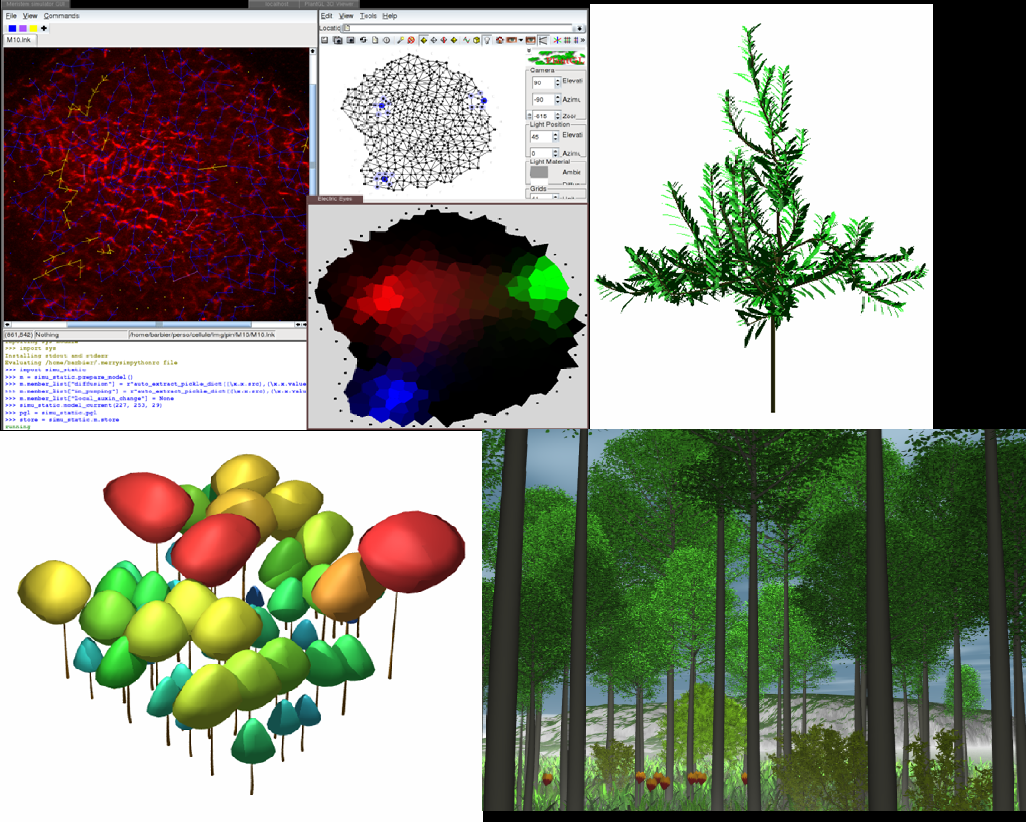Section: Software and Platforms
V-Plants
Participants : Frédéric Boudon, Christophe Godin [coordinator] , Yann Guédon, Christophe Pradal [software architect] , Jean-Baptiste Durand, Pascal Ferraro, Julien Coste, Guillaume Baty.
Computer algorithms and tools developed by the Virtual Plants team are integrated in a common software suite V-Plants, dedicated to the modeling and analysis of plant development at different scales (e.g. cellular tissue, whole plant, stand). The VPlants packages are integrated in OpenAlea as Python components. Several components are distributed and usable through the visual programming environment (see figure 1 ):
-
Multi-scale geometric modeling and visualization. VPlants.PlantGL is a geometric library which provides a set of graphical tools and algorithms for 3D plant modeling at different scales [7] . It is used by many other components to represent the geometry of biological shapes from 3D meristems, plant architectures to plant populations. VPlants.PlantGL is built around a scene-graph data structure and provides efficient algorithms and original geometrical shapes (parametric surfaces, dedicated envelops), that are useful for plant modeling.
-
Statistical sequence and tree analysis. Different statistical packages (i.e. VPlants.StatTool, VPlants.SequenceAnalysis, VPlants.TreeMatching and VPlants.TreeAnalysis) are now available in OpenAlea. They provide different models and algorithms for plant architecture analysis and simulation.
-
Meristem functioning and development. A first set of components has been created in the last 4-years period to model meristem development in OpenAlea. These tools are currently being integrated thoroughly in the platform so that modelers and biologists can use them, and reuse components easily (for meristem 3D reconstruction, cell tracking, statistical analysis of tissues, creating and manipulating atlases, creating or loading models of growth that can further be run on digitized structures, etc).
-
Standard data structure for plants. A new implementation of the MTG formalism for representing and manipulating multiscale plant architecture has been developed. It provides a central data-structure to represent plants in a generic way in OpenAlea. This implementation is available through the packages OpenAlea.MTG. These components make it possible to share plant representations between users and fosters the interoperability of new models.
-
Simulation system. The study of plant development requires increasingly powerful modeling tools to help understand and simulate the growth and functioning of plants. In the last decade, the formalism of L-systems has emerged as a major paradigm for modeling plant development. Previous implementations of this formalism were made based on static languages, i.e. languages that require explicit definition of variable types before using them. These languages are often efficient but involve quite a lot of syntactic overhead, thus restricting the flexibility of use for modelers. We developed L-Py [2] an adaptation of L-systems to the Python language (basis of OpenAlea). Thanks to its dynamic typing property, syntax is simple, code execution is made easy and introspection property of the language makes it possible to parameterize and manipulate simply complex models. Independent L-systems can be composed to build-up more complex modular models. MTG structures (that are a common way to represent plants at several scales) can be translated back and forth into L-system data-structure and thus make it easy to reuse in L-systems tools for the analysis of plant architecture based on MTGs. Extensions to integrate multiscale dynamic models are currently being developed in collaboration with P. Prusinkiewicz and his team from the University of Calgary.
|



